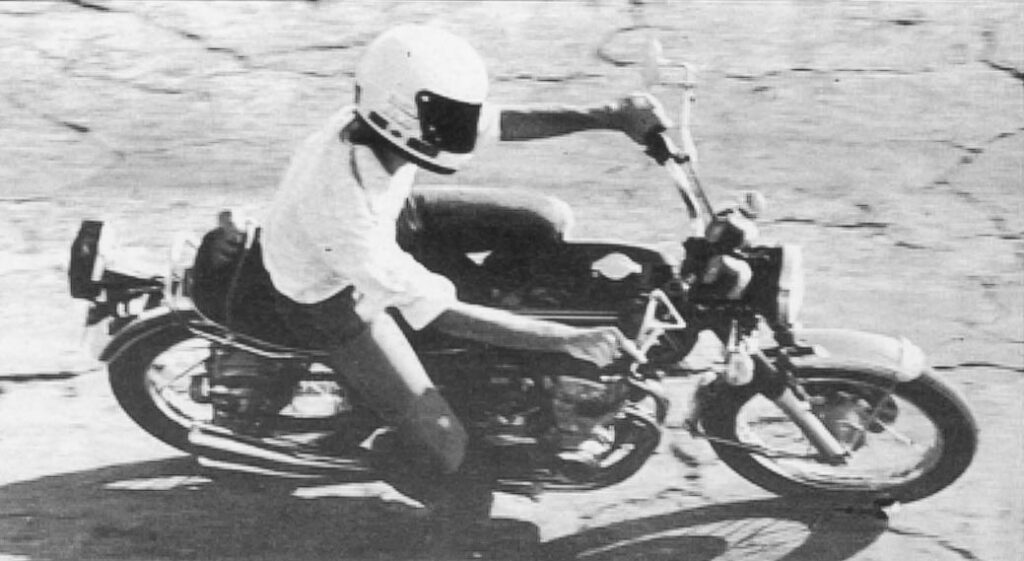| September 8, 2024
Cycle News Archives
COLUMN
Great idea, but… At least it paved the way to greatness.
By Kent Taylor
In 1975, Honda’s CB400F Supersport was just about the coolest thing this side of Starsky and Hutch and their Ford Gran Torino. The nifty little four-cylinder bike stood out like a bright red (or blue or canary yellow) sore thumb in Honda’s mid-’70s lineup. With its dazzling four-into-one exhaust, clubman bars, and a simple yet stylish fuel tank, the CB400F didn’t look like it was born in Japan. It didn’t even really look like it was European. This was a unique machine, so pretty to look at it that it didn’t matter that its four silver-dollar-sized pistons whimpered out only 37 horsepower!
 The Honda CB350 Four didn’t pan out, but it paved the way for a real beauty, the CB400 Four.
The Honda CB350 Four didn’t pan out, but it paved the way for a real beauty, the CB400 Four.
It was a motorcycle magazine editor’s favorite. Translation: a showroom dud that would eventually garner status as moderately collectible. Which is much more than can be said for its predecessor, the Honda CB350 Four. While the moto-journalists of the time showered the 1975 CB400F with praise fit for a princess, the 1974 Honda CB350 Four was seen as the ugliest of the ugly stepsisters!
“Hey, 350 Four, What Are You?” blared the Cycle News headline in August 1974. The 350 had been in Honda’s lineup for three years, having joined its bigger brothers (750cc and 500cc) in 1972. The road test editor was clearly puzzled by this motorcycle, which he described as having “the heart of a Ferrari in the body of a Buick.” The “jewel-like engine” was mostly sleepy, though it would wake up and roar in the 6500-10,500 rpm range, which was still not enough to mollify the writer. “All the lovely Sturm and Drang (a short period of 18th-century German romanticism, possibly the such reference to be found in the history of moto journalism) notwithstanding, it’s probably slower than Honda’s 360 twin,” he wrote, adding that at some point during the test, the meek little four was humiliatingly blown into the weeds by a 175cc enduro bike!
The lambasting that began with the powerplant continued with the description of the handling. The bike was delivered with 1600 miles on the clock, enough to wear out the stock rear suspenders. “A new low,” wrote CN, “in boingy Japanese shock behavior.” It was a “pogo stick with handlebars.” In the twisties, the Honda’s cornering performance was given a sound lashing in the story, with “wobbly” being the least derisive term used by the writer. As with most motorcycles of that era, moderate lean angles resulted in the rude introduction of metal to concrete: centerstand, meet pavement! Motorcycle magazine editors often griped about this one and the manufacturers apparently heard these complaints. The next time you imagine how your chain could be more easily serviced if only your $15K street bike had been equipped with a centerstand, be sure to find an old motorcycle journalist somewhere to thank.
 Cycle News was not impressed with the Honda CB350 Four to say the least.
Cycle News was not impressed with the Honda CB350 Four to say the least.
Poor performance, subpar handling—somebody stop this motorcycle! Good luck! The Honda’s front brake offered “little braking torque for a whole lot of lever effort.” The editor also felt that the front fork would “twist” under heavy braking, setting up the rider for a nasty twitch, something especially disconcerting when entering a corner. The 350 weighed only 375 pounds, but the staffer felt that was about 100 pounds more than it was capable of carrying.
 The CB350 Four had an identity crisis.
The CB350 Four had an identity crisis.
The motorcycle also displayed several un-Honda-like characteristics. The head gasket wept oil, taillights blew out, and the little bike had a nasty primary drive lurch that took some getting used to. The paint quality was lacking, and the staff was miffed to see that the “steering, ignition and seat/helmet locks all take the same key, all inscribed the key number they accept to facilitate easy theft.”
Despite all of the verbal barbs, the writer still believed this motorcycle wasn’t a total write-off and added a sidebar article that would give a potential buyer an opportunity to come down off the ledge. A pair of Boge/Mulholland shocks were fitted to the CB350, and the change did it some good, as the bike now seemed stiffer in the rear. However, the slightly longer shocks naturally created some new issues with the front end.
Hindsight is 20/20 and usually worth almost nothing, but it is good to point out that early to mid-’70s street motorcycles presented would-be buyers with a dilemma. Many high-performance machines were still of the two-stroke variety and their finicky powerbands made them difficult to ride. More pleasing were the big four-stroke motorcycles, though many of them lacked punch. Only one such machine, Honda’s legendary CB750, could deliver high performance and still behave like a mannerly motorcycle. It had been Honda’s first big bike, and it rightly owns its legacy. Cycle News apparently expected the little Honda to act just like its big brother. Like many parents, they were disappointed in the end result.CN